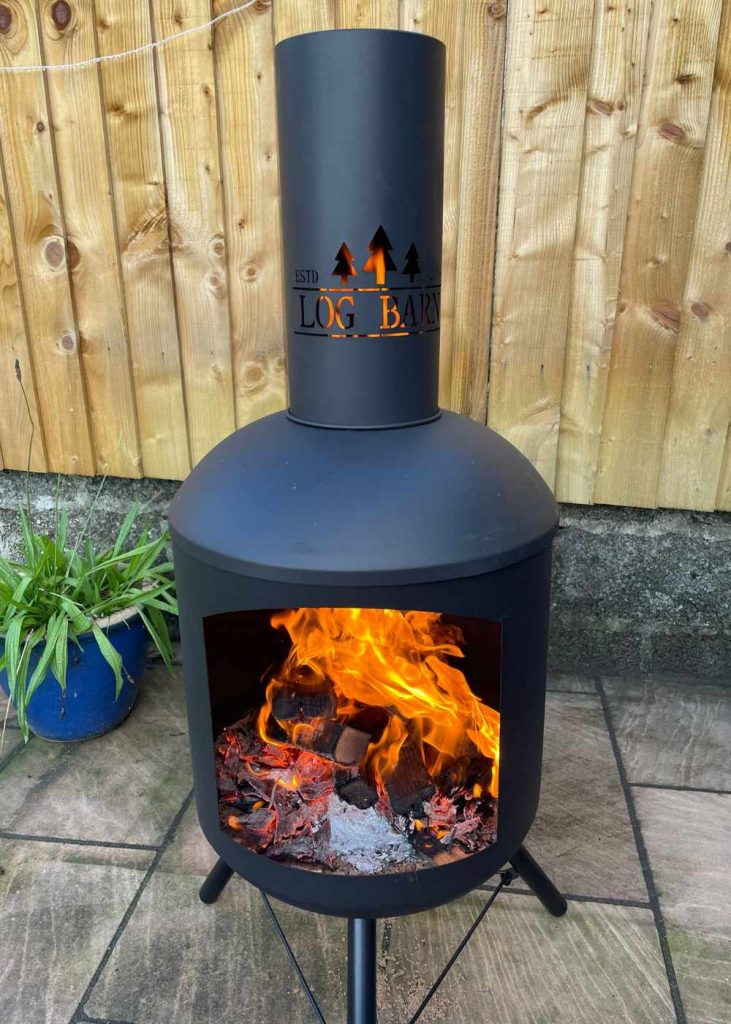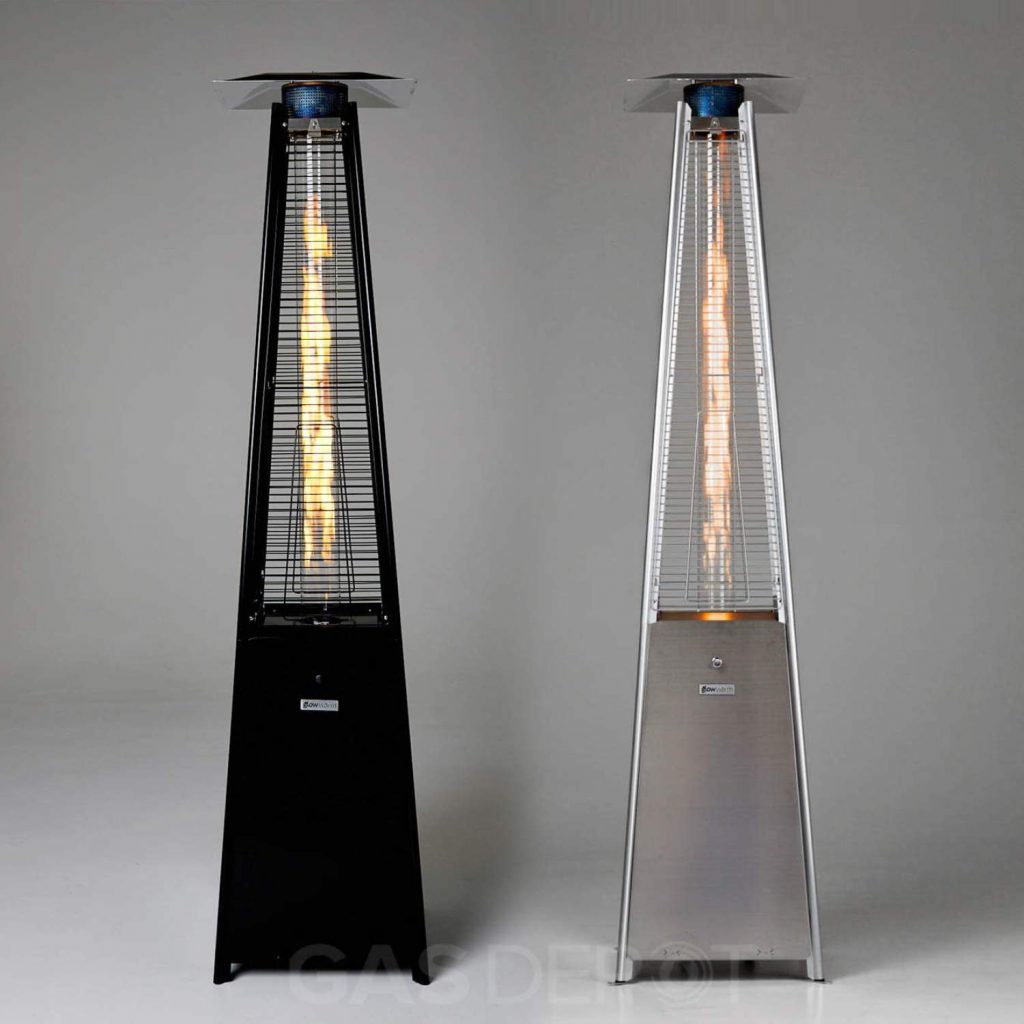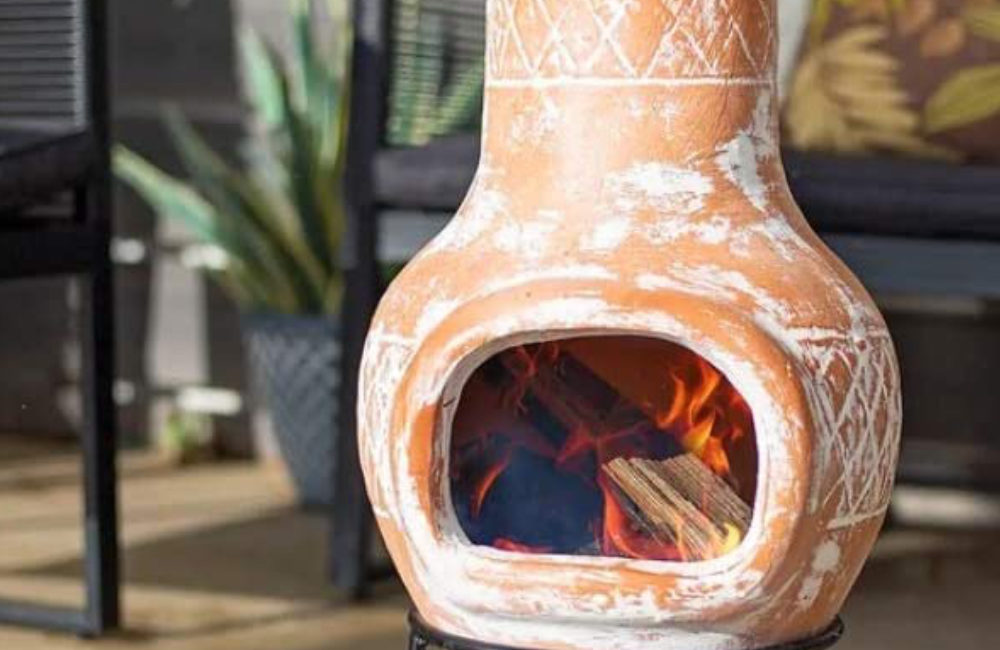Affiliate Disclosure: As an Amazon Associate, we earn from qualifying purchases.
Chimineas have been a popular outdoor patio accessory for many years. They are attractive and offer an inviting, cozy atmosphere, but are Chimineas Good Patio Heaters?
Chimineas make fantastic patio heaters and in this blog post, we will discuss the pros and cons of using a chiminea as a patio heater, so that you can make an informed decision about whether or not it’s the right choice for your outdoor space.
What is a Chiminea?

A chiminea is a traditional, freestanding outdoor fireplace. Originating in Mexico, chimineas are made of clay or metal, and feature an open-air design with an opening at the front and a chimney-like shape. They are often used as patio heaters, providing warmth and ambiance to outdoor gatherings and events.
Chimineas come in a variety of sizes, styles, and shapes, and can be made from either clay, steel or cast iron.
Clay models tend to look more rustic and are typically cheaper than their metal counterparts. Metal chimineas are usually more modern looking and offer better insulation from the heat.
The main advantage of a chiminea is that it is portable and can be used on almost any outdoor surface.
They are also relatively inexpensive, easy to light, and are fueled by either wood logs or charcoal. Chimineas provide a pleasing visual aesthetic as well as warmth, making them a popular choice for creating an a great atmosphere for parties or intimate evenings.
The Benefits of a Chiminea
Chimineas are great outdoor heaters and provide a cozy atmosphere to any patio. They look beautiful and bring a special charm to the area. Here are some of the advantages of having a chiminea in your outdoor space:
1. Portable: Chimineas are easy to move around, which means you can use them anywhere you want. This makes them an ideal choice for camping trips or gatherings with friends.
2. Heat Source: With its open fire, a chiminea will provide enough warmth to keep you and your guests comfortable during the cold winter months. Take a look at our How Hot Does a Chiminea Get? article to see how hot they can get.
3. Decorative: Chimineas are eye-catching and make a great focal point for any patio. With a range of colors and styles, there is something to suit any taste.
4. Durable: As long as you take proper care of your chiminea, and keep it covered when not in us it should last for many years. They’re made from durable materials but make sure you protect them from the elements, so you don’t have to worry about it rusting or deteriorating over time.
5. Low Maintenance: Compared to other patio heating solutions, chimineas require very little maintenance. All you need to do is occasionally clean out the ashes and check that the fire is burning properly.
Overall, chimineas are an ideal choice for adding warmth and ambiance to your outdoor space. They’re easy to maintain, and can be moved around with ease, making them perfect for gatherings with friends or just relaxing by yourself.
The Drawbacks of a Chiminea
Although chimineas are an attractive and popular option for patio heating, there are some drawbacks to consider before you make a purchase.
One of the most important considerations is safety. Chimineas can produce a lot of heat, and they must be used with caution to prevent the risk of a fire. It is important to only use wood or charcoal fuel in a chiminea and to never burn flammable liquids. In addition, you should keep combustible items such as furniture or plants away from the heat source.
Another potential drawback is that chimineas are made of clay, which can be fragile and prone to cracking. If you plan on using a chiminea regularly, it’s important to protect it from the elements to help reduce the risk of cracking.
Additionally, the clay can be difficult to clean, so it’s important to regularly brush out any ashes and soot to ensure optimal performance.
Overall, chimineas can be a great option for adding warmth and ambiance to your outdoor space, but it’s important to weigh the benefits and drawbacks before making a decision.
What is a Patio Heater

Patio heaters are a great way to extend the outdoor season and enjoy your outdoor living space even in the colder months.
They come in many styles, ranging from electric or gas, to propane-powered models. Patio heaters are designed to provide warmth and light, and may be used to create an inviting atmosphere for outdoor gatherings, such as dinner parties or family get-togethers.
There are two main types of patio heaters: radiant and convection. Radiant patio heaters use infrared radiation to warm people and objects nearby, while convection patio heaters use convective currents to warm the surrounding air.
Both types of patio heaters provide comfortable temperatures and are typically safe to use outdoors.
Propane and gas-powered patio heaters can be more expensive to operate than electric models, but they have a longer running time and often provide higher temperatures.
Electric patio heaters can provide an inexpensive option for heating small areas, but they usually have a shorter running time and may not be suitable for larger spaces.
No matter what type of patio heater you choose, make sure it is designed for outdoor use and that you follow all safety instructions for proper use and maintenance.
The Benefits of an Electric Patio Heater
Electric patio heaters offer many benefits for outdoor entertaining.
They are more efficient and cost effective than traditional wood-burning heaters, and provide a more consistent heat output.
Unlike wood-burning heaters, electric patio heaters don’t produce smoke or require maintenance, making them ideal for use in enclosed spaces.
Electric patio heaters come in a variety of sizes and designs, making it easy to find one that fits the style and size of your outdoor area.
Additionally, electric patio heaters are often cordless and battery operated, making them incredibly portable and convenient. Finally, electric patio heaters have adjustable settings so you can adjust the temperature to suit the needs of your guests.
Drawbacks of Electric Patio Heaters
When it comes to electric patio heaters, there are some drawbacks that should be considered before making a purchase.
For one, electric patio heaters tend to be more expensive than other types of heaters. Additionally, since they rely on electricity to power them, they need to be plugged in or connected to a source of power, which can limit their placement options.
They are also limited in terms of the size of the area they can heat, and they tend to be less energy-efficient than gas-powered heaters. Finally, electric patio heaters may not be able to reach temperatures as high as those achievable by gas-powered heaters.
Benefits of Gas Patio Heaters
Gas patio heaters provide a convenient and efficient way to heat your outdoor space. Gas patio heaters are easy to install and use, meaning you can set up your heater and start using it right away.
Unlike electric patio heaters, gas patio heaters don’t require any additional wiring or electricity, so there are no installation costs or complicated electrical work to worry about.
Gas patio heaters also offer fast heating performance, with most models reaching their maximum temperatures in as little as five minutes. This makes them ideal for those chilly nights when you just want to enjoy the outdoors without having to wait around for your heater to warm up.
Gas patio heaters are also incredibly efficient when it comes to fuel consumption. Most models have adjustable heat settings, allowing you to adjust the amount of fuel used depending on your needs. This means you can save money on fuel costs by only using what you need and avoiding wasteful burning of extra fuel.
Finally, gas patio heaters provide a safe and reliable source of heat. Most models feature safety shut-off systems and protective grills, ensuring that your outdoor living space is well heated without any risk of fire or burns.
Drawbacks of Gas Patio Heaters
Gas patio heaters are a great way to keep your outdoor area warm and cozy during the colder months, but they also come with some drawbacks.
Firstly, they can be more expensive than other types of patio heaters. For example, gas patio heaters will typically require more investment in terms of installation and maintenance. Furthermore, you’ll need to factor in the cost of refilling the gas tank or replacing it when needed.
Additionally, gas patio heaters produce carbon dioxide emissions and therefore may not be suitable for smaller enclosed spaces. If your patio is close to neighbors or other buildings, you will need to take extra care to ensure that any emissions do not cause health concerns for anyone nearby.
Finally, many gas patio heaters are quite bulky and take up a lot of space. This can be a problem if you have limited outdoor space or want to move the heater around from time to time. As such, they may not be suitable for smaller patios or balconies.
Overall, gas patio heaters are a great choice if you’re looking for an efficient and powerful way to heat your outdoor area. However, it’s important to weigh up the pros and cons before investing in one.
Are Chimineas Good Patio Heaters?
When it comes to deciding between a chiminea and a patio heater for heating your outdoor space, the decision really comes down to personal preference.
Chimineas are great if you’re looking for something that looks attractive and is easy to move around. They provide a nice ambiance to an outdoor gathering, but may not be the most effective way to heat a large area.
Patio heaters on the other hand are more powerful and can heat a larger area quickly, but they are typically more expensive than a chiminea and have a more industrial look.
Ultimately, it comes down to what suits your needs best and what style you prefer.
You can find a range of fantastic Gas and Electric patio heaters by visiting our sister website Justpatioheaters.co.uk or take a look at our shop for some fantastic chiminea.

